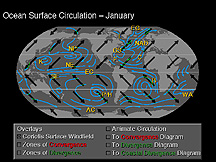 Image from Animation
Image from Animation
...to Geog 111 Main Page and Course Description
...to Geog 111 Syllabus
...to Geog 111 Course Schedule and Lecture Outlines
...to Geog 111 Course Project
Last few lectures: brief overview of the atmosphere, climate and weather
1. Composition of the Atmosphere
2. Vertical Structure of the Atmosphere
3. Weather and Climate
Introduction to the Hydrosphere
1. The Nature of Water
McKnight fig 9.2
Can be a solid (ice), liquid (water) or gas (water vapor)
Processes which cause it to change from one state to another
Can absorb much energy (heat)
Water contracts (down to 39 degrees)
Water also readily dissolves other substances
...look in more detail at the movement of water: the hydrologic cycle
2. The Hydrologic Cycle
McKnight fig 9.4
Animation) Hydro Cycle
McKnight fig 9.5 Hydro Cycle
Residence Times: water remains for variable amounts of times at different
stages in the hydro cycle
Given that: look at seven components of the hydrological cycle and
corresponding physical processes
2a. Surface to Air Water Movement
Two primary sources: surface waters and land
Surface Waters as source...
McKnight 6.3: Evaporation: How it Works
Land as source...
McKnight 9.5: hydro cycle
Transpiration: water entering the air from the land
2b. Air to Surface Water Movement
Processes of condensation and precipitation
Condensation is the opposite of evaporation
Precipitation originates in clouds (which consist of water vapor)
Overall balance between worldwide evaporation and worldwide precipitation
2c. Movement on and Beneath Earth's Surface
McKnight 9.5
Geographic imbalances...
Due to advection: horizontal movement of moisture in the atmosphere
Would suggest that the oceans over time should dry up, and land should be flooded
The water that falls (precipitates) on land has a complicated path
Runoff is approximately 7% of all moisture circulating in the global hydro cycle
Next: the places in the hydro cycle where water is stored a bit longer: residence times
2d. The Oceans
Oceans as a Human Concept
One 'Global Ocean' but humans have divided that up into smaller areas
Characteristics of Ocean Waters
Characteristics of the ocean have geographic variations
Variations in chemical composition, temperature, and density
Chemical Composition Variations
Dissolved minerals make up about 3.5% of ocean water's bulk
Salinity is a measure of concentration of salts in ocean water
Salinity varies from place to place
Middleton fig 9.6: Oceans
Temperature Variations
Closely related to latitude
Density Variations
Density of water varies
Movement of Ocean Waters
Ocean in constant movement
Tides
Daily patterns of sea level fluctuations
Currents
ANIMATION) Ocean Currents
Waves
2e. Permanent Ice
McKnight 9.8: global ice
Most permanent ice is on land
Ice nomenclature
McKnight 9.9: Arctic Ice
McKnight 9.10: Antarctic Ice
WWW) International Ice Patrol Site
Ice floe: large flat chunk of ice that breaks off larger ice mass and floats independently
Iceberg: chunk of floating ice broken off from larger ice mass
McKnight 9.11: Permafrost
Next: water stored on earth's surface...
2f. Surface Waters
Holds about .25% (1/4 of 1%) of world's moisture supply
Lakes
Lake: a body of water surrounded by land
Two conditions necessary for lake formation
McKnight fig 9.12: freshwater vs saltwater lakes
Uneven geographic distribution of world lakes
Most lakes are temporary...less than a few thousand years old
Wetlands: Swamps and Marshes
Rivers and Streams
Provide the means by which the land surface drains and by which water, sediment, and dissolved chemicals are moved seaward
Location and occurrence of rivers and streams related to precipitation
McKnight fig 9.18
Major river drainage basins: all the land drained by a river and its tributaries (branches)
2g. Underground Water
McKnight fig 9.4
About 2.5 times the water contained in lakes and streams
Usually stored near the surface
Broader distribution than surface water: almost everywhere underground
Porosity: percentage of the total volume of the material that consists of voids
(pore spaces or cracks) that can fill with water
The movement of water underground is also very important
Permeability: ability to transmit underground water; ability to allow water to move through the material: determined by size of pores and degree of interconnectedness
The amount of and rate at which water moves through subsurface material depends
on porosity and permeability
Underground water is stored in aquifers
McKnight fig 9.A: Ogallala Aquifer
Aquifers: greek aqua = water and ferre = to bear
McKnight fig 9.19: Components of an Aquifer
aquicludes: underground water storage that is porous, but not permeable
Zone of aeration: mixture of solids, water, air
Zone of saturation: right below the zone of aeration
Zone of confined water: in some areas of the world, another aquifer below the
zone of saturation and separated by a aquiclude
Waterless zone: at some depth, 5-6 miles, there is no longer any water
Sum: Introduction to the Hydrosphere

Most diverse of the earthly spheres
Encompasses oceans, lakes, rivers, wetlands, underground water, frozen water in the form of ice, snow, glaciers, water vapor in the atmosphere and moisture stored in plants and animals
1. The Nature of Water
2. The Hydrologic Cycle
E-mail: jbkrygier@owu.edu
...to Geog 111 Main Page and Course Description
...to krygier teaching page.
...to krygier top page.